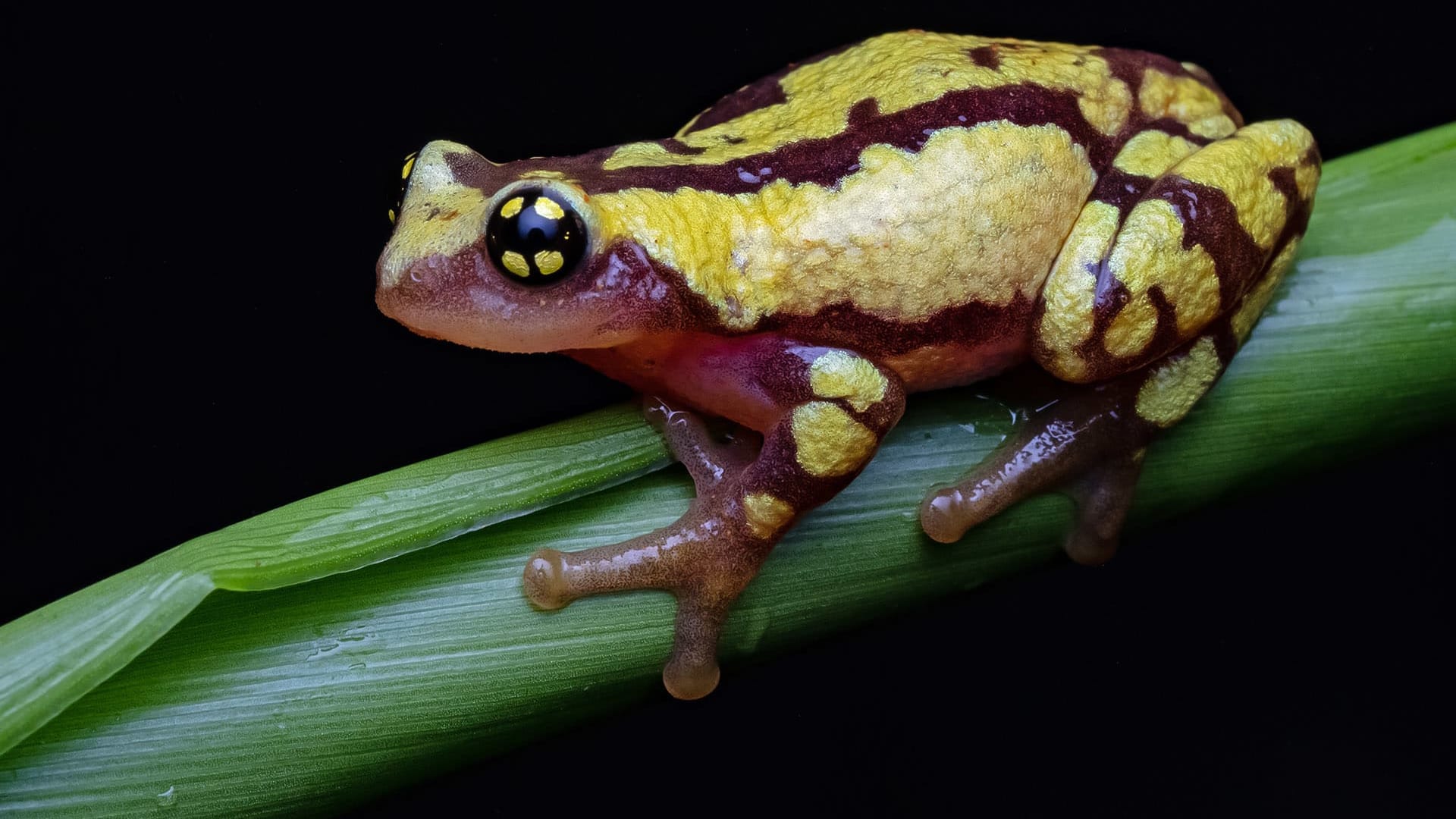 Listen to this article
•
15:34 min
Listen to this article
•
15:34 min
Laid out amidst rolling tea estates and cardamom plantations, Munnar is a popular hill station high up in Kerala’s Western Ghats. The southwest monsoon comes down in torrents here; waterfalls materialise out of the hillside in full spate and bone-chilling mist drives people to the warmth of roadside tea stalls. The tourist traffic typically winds down by sunset, but nightfall welcomes people armed with headlamps into the plantations, keeping an ear out for calls of thumb-sized frogs. A hard “trr” emanates from the darkness, answered by a softer call further away. Flashlights scan the tea leaves to reveal a blue-spotted Beddome’s bush frog (Raorchestes beddomii), practically engulfed by its expanding vocal sac. Bush frogs or shrub frogs (Genus: Raorchestes) are typically arboreal (tree-living) and measure just 1.5-4.5 cm. These bush frogs from southwestern India, living south of the Palakkad Gap, are believed to have diverged from their cousins of the north more than 15 million years ago.
Such tiny nocturnal animals have always been easy to overlook, but a conversation with Sandeep Das, herpetologist and ZSL EDGE Fellow, highlights a recent change in this trend. While many people continue to focus on more charismatic animals, herping, the search for reptiles and amphibians, has become increasingly popular among naturalists, photographers, and tourists. This rising fascination with herpetofauna indicates a shift in focus towards oft-ignored species and could help shed light on the need for their conservation.
However, the increased attention has its drawbacks. Unnecessary and improper handling of frogs in the name of conservation photography places undue stress on the animals, and recent research has shown that the fungal pathogen causing chytridiomycosis, a disease that threatens amphibians worldwide, could be spread by humans as well. Sandeep recommends the institution of stringent biosafety protocols, such as wearing gloves while handling frogs for research purposes. He also encourages photographers to understand their responsibility towards the animal’s well-being while creating images.

Researchers discovered a brown and cream-yellow bush frog with bright yellow-splotched pupils in thickets of a native bamboo species (Ochlandra setigera). Following mating, they observed the female laying her eggs in the hollow cavities found within the bamboo stems, leaving the male to guard the eggs. This behaviour earned it the name Ochlandra shrub frog (R. ochlandrae). Such breeding behaviour and parental care associated with bamboo was first noticed in India in the chalazodes bubble-nest frog (R. chalazodes) in 2009, after which it was recorded in other bush frogs as well.
The significance of these frogs’ dependence on bamboo thickets for their reproduction is underlined by the recent discovery that the skulls of bamboo-breeding frogs have evolved to facilitate their entry into small cavities. This morphological diversification dates back to the Miocene era when reed bamboos first emerged on the scene. Considering this dependence on bamboo, curbing bamboo harvest during the breeding season could be crucial for their conservation.
Closer to Munnar town, a night walk through shade-grown cardamom plantations and tea estates could lead you to species such as (1) Griet’s bush frog (R. griet), (2) Sushil’s bush frog (R. sushili) and (3) Ponmudi bush frog (R. ponmudi) — with the first two being endemic to the region. All these frogs are critically endangered, having lost their habitat to the modification of shola forests through logging and conversion to plantations.
Controlled fires used to manage the montane grasslands take their toll on the slow-moving amphibians found here, both directly and indirectly, when protective grass cover is lost. Considering the restricted range of grassland-dwelling species like (4) the resplendent shrub frog, the consequences of such actions can be quite dramatic for their populations. Besides habitat alteration, the spread of Batrachochytrium dendrobatidis, the pathogen causing chytridiomycosis (an amphibian fungal skin disease that can be fatal), affects the frogs of Munnar as well.
Perceived in a positive light by the locals of Munnar, bush frogs form an integral part of this region. Hopefully, their symphony of calls will continue to enrich the soundscape of monsoon nights in the years ahead.
















